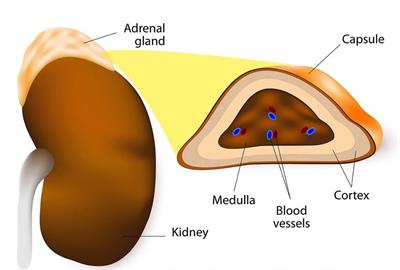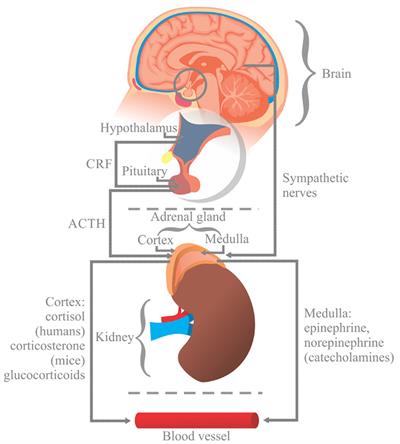PDF chapter test TRY NOW
The adrenal glands are paired structures that are located above each of the kidneys. They are also known as suprarenal glands. The adrenal gland has two parts:
1. Adrenal cortex- the outer part of the adrenal gland. A fibrous capsule surrounds the adrenal cortex.
2. Adrenal medulla - the inner part of the adrenal gland.
Both the parts are structurally and functionally different from each other.

Adrenal gland
I. Adrenal cortex:
The adrenal cortex is further subdivided into three zones:
a. Zona glomerulosa - outer zone of the adrenal cortex. The zona glomerulosa cells are closely packed and arranged in clusters. It secretes hormones called mineralocorticoids.
b. Zona fasciculata - middle zone of the adrenal cortex. The cells of zona fasciculata are arranged in long, straight columns. It secretes glucocorticoids.
c. Zona reticularis - inner zone of the adrenal cortex. It secretes gonadocorticoids like androgens.

Composition of the adrenal gland and the hormones they release
Hormones of Adrenal Cortex:
All the hormones secreted by the adrenal cortex are synthesized from cholesterol. The hormones secreted by them are corticosteroids. The corticosteroids are classified into three categories:
i. Glucocorticoids
ii. Mineralocorticoids
iii. Gonadocorticoids
Functions of adrenocortical hormones:
1. Glucocorticoids:
The glucocorticoids secreted by the zona fasciculata are cortisol, corticosterone and cortisone.
- Glucocorticoids affect carbohydrate metabolism.
- Glucocorticoids regulate cell metabolism.
- It stimulates the synthesis of glucose from glycogen in the liver.
- It also stimulates the breakdown of fats in adipose tissue.
- Glucocorticoids are anti-inflammatory and anti-allergic agent.
Important!
The cortisol hormones secreted by the adrenal cortex maintains the body in living condition and help it recover from the adverse effects of stress reactions. Increased production of cortisol is observed in "shock conditions" is "life-saving". It is also referred to as "Life-saving hormone".
2. Mineralocorticoids:
The mineralocorticoids secreted by zona glomerulosa is aldosterone. They are responsible for the regulation of mineral metabolism.
- Aldosterone helps to reabsorb sodium ions from the renal tubules. This causes an increase in sodium ion concentration in the blood.
- It causes increasedexcretion of potassium ions.
- Aldosterone regulates the electrolyte balance, body fluid's volume, osmotic pressure and blood pressure.
3. Gonadocorticoids:
They are also called sex hormones of the adrenal glands. The male sex hormones secreted by the adrenal cortex are called androgens. The female sex hormones secreted by the adrenal cortex are oestrogen. Sex hormones are responsible for the development of secondary sexual characters.
II. Adrenal medulla:
The adrenal medulla is composed of rounded groups of granular cells.
These cells are called chromaffin cells or phaeochromocytes.
They are richly supplied with sympathetic and parasympathetic nerves.
Hormones of Adrenal Medulla:
The medulla of the adrenal glands secretes two hormones that include:
i. Epinephrine or adrenaline
ii. Norepinephrine or noradrenalin
The hormones together are collectively called "Emergency hormones". The hormones are produced during the conditions like stress and emotions. Hence it is also referred to as “flight, fright and fight hormone”. Due to the role of the hormones, the adrenal glands are called "Glands of emergency".
Functions of adrenal medullary hormones:
1. Epinephrine:
- Epinephrine promotes the conversion of glycogen to glucose in the liver and muscles.
- It causes increased activity of the heart that increases heartbeat and blood pressure.
- Epinephrine increases the rate of respiration through dilation of bronchi and trachea.
- It causes dilation of the pupils of the eyes.
- Epinephrine causes the constriction of blood vessels and thus decreases blood flow through the skin.
2. Norepinephrine or noradrenalin: It causes similar effects like those caused by epinephrine.

Pathway of release of hormones from adrenal cortex and medulla
Reference:
https://www.flickr.com/photos/143951580@N06/46556419855/in/photolist-2dW2PC4-9Ls4eL-doi3hJ-mpcFQW-5SCk1b-bNNtNT-5bQFni-4j7aVc-M6k7AD-8LSzA1-bXAMpq-6hdwiE-9P4MdW-9WbzHc-6sTBtJ-4aJYaD-8oY1Wd-CqGuoi-9wZAis-cfm2rd-eKqxGV-2bjXt7V-2i2NDgg-5ENC9J-eb9zpR-cFq6m-cFq6E-cFq6o-cFq6s-cFq6A-5EJjb4-5ENAvQ-5EJjUP-7KAqVW-bCKzNt-2iMT5c8-2iMZJ5V-5ENAcb-9uQi7r-5ENzSo-dVDaic-2T2vrw-4sYbpk-e9tkJB-ea2EaG-ea2E7J-e9z1vb-ea2E6C-e9tkNx-e9z1sw
https://upload.wikimedia.org/wikipedia/commons/c/ca/1818_The_Adrenal_Glands.jpg
https://commons.wikimedia.org/wiki/File:Response_to_stress.jpg
https://upload.wikimedia.org/wikipedia/commons/c/ca/1818_The_Adrenal_Glands.jpg
https://commons.wikimedia.org/wiki/File:Response_to_stress.jpg
